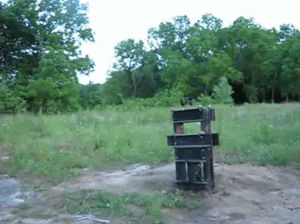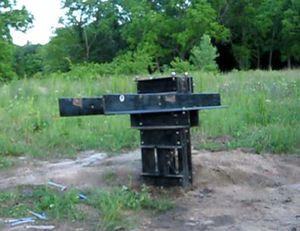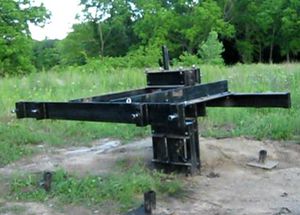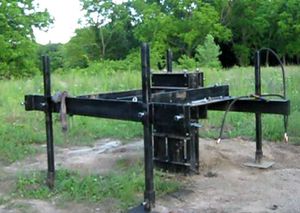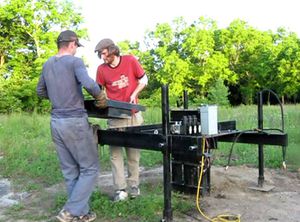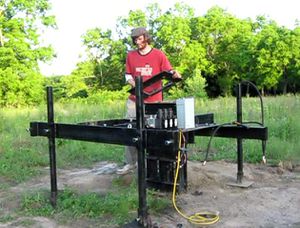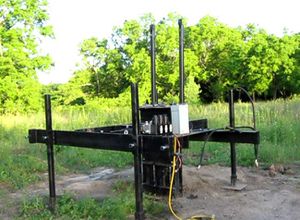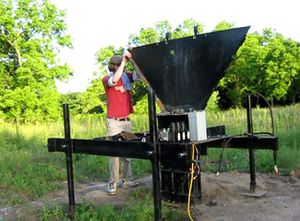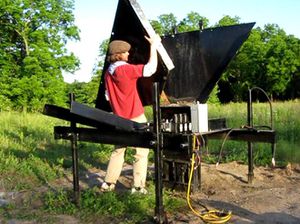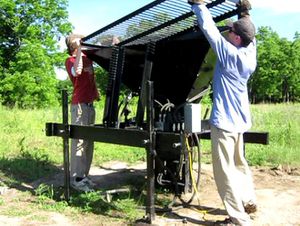The Liberator Assembly
Assembly
This is the current assembly, it is in progress, expected to be completed by the end of october:
CEB Press Prototype III Assembly
CEB Press Prototype III Assembly- Adjusting the drawer
CEB Press Prototype III Assembly- Soil loading system
CEB Press Prototype III Assembly- Installing the secondary cylinder
Below is the old version.
After unpacking the crate as in The Liberator Packing List, or building the components, you are ready to assemble the machine. The assembly procedure is the reverse temporal order of the disassembly video from the blog:
Assembly begins by locating a flat spot on the ground, preferably in a covered space in case of foul weather. This video shows the process and discusses some of the details, and the steps below give further details.
Note: Front in the following discussion is defined as the part of the machine, facing the hopper aperture, closest to the viewer. Left and right are defined accordingly by viewing the machine from the front. When the discussion moves to the solenoid valve and control box, left and right are defined with the viewer facing the control box.
- Place the main frame flat on the ground as shown in figure Step 1. The machine front is defined as the orientation of the frame in which the main cylinder sensor is on your right hand side when facing the machine frame. Right and left sides are defined accordingly.
- Attach the primary arms using the bolts provided. The primary arms are those arms without the leg holders. The right hand arm, which is the one with the greater number of holes, should be on the right side shown in Step 2. Do not tighten the bolts at this point, until the secondary arms are fit onto the primary arms.
- Attach the secondary arms using the bolts provided. The front arm shown in Step 3 is the one with the secondary cylinder attachment eye, and the 4" side of this arm is below the 6" side. The rear arm has the 6" side oriented below the 4" side.In this step, attaching the front arms will make the machine tilt forward unless it is otherwise supported by holding, jacking up, or inserting the legs, as in the next step. Tighten down the secondary arm bolts, and once these are tightened, the primary arm connection to the frame may be tightened up.
- Attach the legs and feet by placing the legs in the sleeves and tightening the bolts. Attach the legs in the outer leg positions, not in the inner position as shown in Step 4.
- Attach the solenoid valve with 2 bolts (3/8") into the corresponding set of holes. There should be a hole in the frame below the pressure relief on the valve. There is only one way that the solenoid valve can be attached, so the corresponding holes should be apparent.
- Attach the controller box using one 1/2" bolt to the right of the solenoid valve.
- Install the roller guides. The guides can go in only one way - the guide body should be over the guide roller adjusters. Do not overtighen the bolt that connects the roller guides to the u-channel. The roller guides should be able to pivot slightly around this bolt
- Install the soil-loading drawer into the frame, as in Step 8. Adjust the roller guide adjustment bolts (4 of them) such that the drawer can roll freely on the guides, with its bottom not touching the frame throughout its motion. The top of the drawer should not touch the frame either. Adjust the roller guide ajustment bolt such that the top surface of the drawer barely touches the frame, while the space on the bottom may be larger.
- Install the hopper mounting plate and tighten the 4 bolts as in Step 9. The wider edge of the plate should face forward.
- Install the rear hopper supports, as in Step 10. Wait for the rear hopper sheet to be installed to determine the vertical adjustment of the rear hopper supports.
- Install the back piece of the hopper. This is the largest sheet. See Step 11. Bolt this sheet to the 2 hopper-attachment-plate hinges, and to the 2 rear supports using the bolts provided.
- Attach the front hopper supports to the arms, and install the front hopper sheet. Bolt the front sheet to the hopper-attachment-plate hinges and to the support arms. See Step 12.
- Attach the remaining side hopper sheets.
- Install shaker motor. The rotor shaft goes in through the hole in the back hopper section. The shaft-with-eccentric-rotor must be taken out of the hopper shaker assembly for mounting. To remove the shaft, loosen the two collars (set screw + turn), and loosen the bolts on the second pillow block bearing, and disconnect the coupler (bolt pin + set screw) from the shaker motor. Then mount the hopper assembly on the rear hopper supports, with the shaft in place through the hole. Attach the hopper shaker to the second rear support with the provided connecting piece. Then tighten the shaft - start with the pillow block bearing and the shaker motor bolts. Tighten the motor bolts and pillow block bolts gradually, so that the shaft remains aligned and does not stiffen up. You should be able to turn the eccentric by hand easily once everything is tightened. If the eccentric does not spin freely, then loosen and retighten the bolts. Make sure that the shaft does not touch the hopper sheet, otherwise adjust the rear hopper sheet position. When everything is in position, tighten the rear hopper supports, rear hopper sheet, shaker motor, and its shaft.
- Mount the grate, as in Step 15. The grate requires 2 people to put into place, as it is heavy. The grate can be mounted only one way. The concave side of the grade should be pointed down. The large grate mounts [1] (2) attach the front, and the smaller grate mounts go on the back of the hopper. Attach the grate mounts to the hopper and rear hopper supports prior to setting the grate on top of the hopper.
- Mount the soil sensor assembly on the grate between bars 13 and 15 (of 33), where the bars are counted from the right hand side. There should be a small gap (1"-2") from the grate to the hopper, such that one could attach the soil sensor bolts through this gap. The cord of the soil sensor should hand over the edge of the grate.
- Begin connecting the hydraulics. The main hoses [2] are 3/4", and 8 feet long, with the pressure relief valve on one end. The Black relief valve is the inlet port from whichever power source you are using. The main hose attaches to the main inlet and outlet ports of the solenoid valve. The inlet of the solenoid valve block is on the left hand side, and the outlet is on the opposite side of the block. Do not use thread tape to attach the hoses, as the valve fittings are compression swivels. Tighten the fittings for a secure connection.
- Connect the first solenoid on the left to the main cylinder, using the 6' long hoses. Port B from the valve goes to the bottom port of the main cylinder.
- Install the secondary cylinder by putting pins through the attachment eyes - on the secondary arms and on the soil-loading-drawer.
- Attach the secondary cylinder hose assembly as shown on the blog to the second solenoid from the left. One plain hose goes directly from the base of the secondary cylinder to port B of the solenoid, and the more complex assembly screws into the rod-end-port of the secondary cylinder, with the opposite end of this hose assembly screwing into port A of the second solenoid.
- Attach the grate shaker motor hoses with the power line connected to port A of the third solenoid. The return line, defined as the line shown in the last picture with the small hose and the needle valve attached to it, connects to port B of the solenoid valve. Use the 6' long hoses. Screw them in first to the shaker motor, where there are no swivels, and then to the valve, where there are swivels. Because the fittings at the shaker motor are not compression fittings, they are the only ones that require the use of thread tape during assembly. Use thread tape going into the shaker motor, and going into the needle valve.
- Attach the electrical connection to the solenoid valves. The longest set of 4 leads go to the first valve (main cylinder) from the left. The second bunch of 4 leads go to the second valve (secondary cylinder), and the last pair of leads goes to the third valve (shaker motor).
- Attach the main sensor to the two power clamps on the right hand side of the main cylinder body, about in the middle of the cylinder. The correct location of the sensor should be visible by the paint markings. Face the cylinder toward the sensor magnet assembly. See the video on the main cylinder sensor assembly elsewhere.
- Attach the secondary cylinder sensor by screwing it into the hole below the right mounting hole of the solenoid valve. The top of the PVC part of the sensor should be even with the height of the upper edge of the machine arms, as shown in the video above.
- Attach the sensor to the a Arduino shield in the controller box. First, run the wires into the right-hand knockout in the controller box. Pay attention to the fragile connection ends so that you do not break them. Connect them to the appropriate pins on the Arduino shield by unscrewing the terminals, putting in the lead, and tightening the terminal down. Do not overtighten, or you may break the leads. Pull on the lead to make sure it is connected securely. The pins of interest on the Arduino shield are A5, A4, and A3 - left-hand-side terminals - which accept the blue (signal) wires of the sensors - for the main cylinder, secondary cylinder, and shaker motor sensors, respectively. For the remaining leads, the blue/white lead is the ground, and the orange/white lead is 5V. Connect the ones for the main and secondary cylinder on the bottom of the shield - into any available slots, as determined by convenience. For the shaker motor, connect the ground and 5V on the top side of the shield. While the signal leads need to be attached to the exact slots, any ground or 5V pin will work for the remaining wires - and may be selected by convenience of location. The useful part about the Arduino shield is that it has a large number of slots for convenience.
With the sensors, solenoids, and hoses attached, the machine may now be plugged into a power source and prepared for initial testing and then for pressing.
Remounting Main Cylinder
